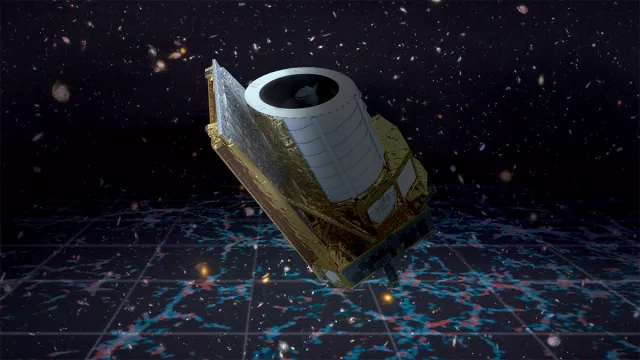On 1 July 2023, the European Euclid satellite departed Earth on an extraordinary mission to map the large-scale structure of the Universe in an effort to understand why it has been expanding at an accelerating rate for the last ten billion years. In so doing, it will be seeking to unveil the secrets of mysterious dark energy and dark matter. Thirteen French research laboratories are involved.
Key information
Key figures
- 40 contributing French laboratories
- 2 instruments
- 170 million Gb of planned data
- 1.2-m-diameter primary mirror
Key milestones
- June 2030: Planned end of mission
- June 2026: Publication of Data Release 1, covering one year of survey (2,500 deg²)
- March 2025: First data release, covering 50 deg²
- December 2023: Official start of mission
- 28 July 2023: Arrival at L2 Lagrange point
- 1 July 2023: Launch by Falcon 9
- March 2022: Final assembly of satellite
- 20 June 2012: Project adopted by ESA
Project in brief
Euclid is the second medium-class mission (M2) of ESA’s Cosmic Vision mandatory science programme, an astronomy and astrophysics mission selected by the agency’s Science Programme Committee (SPC) on 4 October 2011 and adopted on 20 June 2012. It is focused chiefly on cosmology, seeking to study the origin, nature, structure and evolution of the universe, and to advance our understanding of dark energy and dark matter, two components of the cosmos still shrouded in mystery.
The Euclid satellite, for which Thales Alenia Space Italy in Turin is the prime contractor, departed Earth on 1 July 2023. The mission is setting out to map vast sections of the cosmos in an attempt to learn more about the origin and evolution of our universe. The mission’s two main goals are to understand why the universe is expanding at an accelerating rate under the effect of this mysterious “dark” energy, and to map the equally mysterious “dark” matter, which while it remains invisible to the naked eye and to instruments contributes with visible matter—stars, nebulae, etc.—to the gravitational effects that bind stars together into galaxies, and galaxies into clusters. By peering ever farther back in time, Euclid will be attempting to reconstruct how our universe has evolved over the last ten billion years under the opposing effects of dark matter and dark energy.
Over the course of its nominal six-year mission, Euclid plans to survey about a third of the sky, that is, a little under 15,000 square degrees, the remainder being hidden by the galactic plane—the disk in which stars in the Milky Way lie—and by the ecliptic plane—the disk in which the planets in our solar system lie. This survey will be complemented by observations that will go approximately ten times deeper pointed at three fields near the ecliptic poles, one to the north spanning 20 square degrees and two to the south each spanning 10 square degrees. These fields will be regularly visited throughout the mission and will serve to calibrate data and verify the stability of the telescope and instruments, as well as to acquire science data for observing galaxies and the most distant quasars in the universe.
Euclid will thus survey billions of galaxies and the evolution of large-scale cosmic structures as far back as ten billion years, in the visible and near-infrared (from 550 to 2,000 nm). To do this, it plans to determine the redshift (z) of observed sources using spectrometry and photometry instruments, complemented for photometric measurements by telescopes on Earth operating in the visible portion of the spectrum.
Covering such a vast area of sky and with its catalogues of billions of stars and galaxies, the mission will be acquiring science data of value well beyond the field of cosmology. This record of data will provide the global astronomy community with an abundance of sources for decades to come, constituting a repository of new astronomic objects for study by telescopes such as JWST, E-ELT, TMT, ALMA, SKA and the Vera C. Rubin Observatory.
To accomplish this colossal mapping effort, Euclid will be carrying two instruments: the Near Infrared Spectro Photometer (NISP) and the VISible Instrument (VIS), both developed by an international consortium led by France, through the IAP astrophysics institute in Paris (IAP/CNRS). The Euclid consortium comprises more than 2,200 people (425 in France) working at some 250 research laboratories (40 in France) across 16 countries.
CNES’s role
CNES is part of the Euclid consortium and funding the 13 French research laboratories and institutes working on the VIS and NISP instruments. The agency also has a key role in the mission’s ground segment.
Contacts
Project Lead for French contributions to Euclid
Pierre Casenove
E-mail: pierre.casenove at cnes.fr
Astronomy & Astrophysics subject matter expert
Philippe Laudet
E-mail: philippe.laudet at cnes.fr
Fundamental Physics subject matter expert
Martin Boutelier
E-mail: martin.boutelier at cnes.fr


